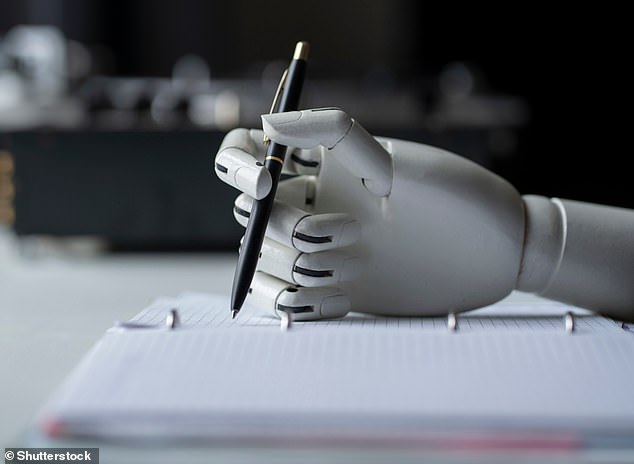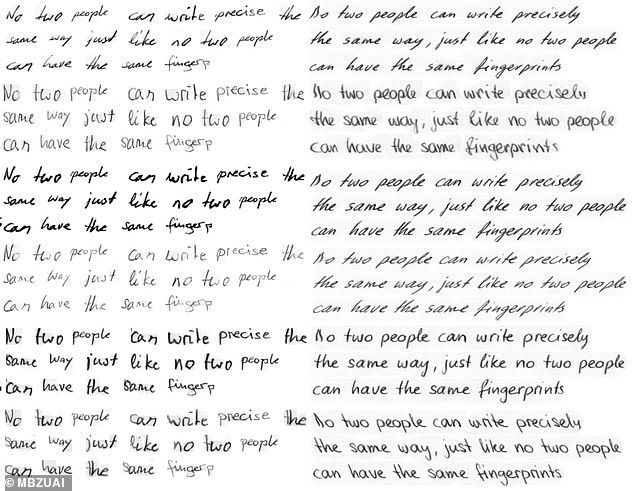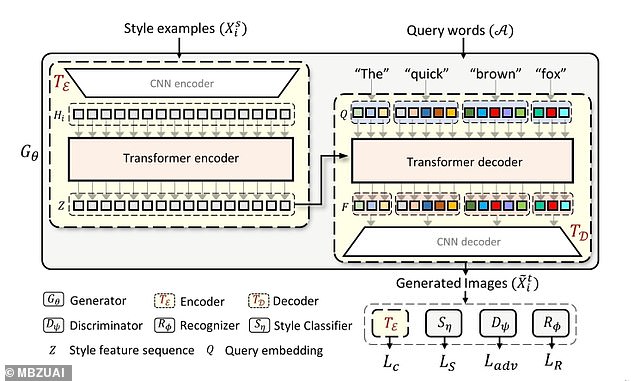AI can now copy your HANDWRITING – so, can you tell which of these was written by a robot?
AI tools like ChatGPT can compose letters, tell jokes and even provide legal advice – but only in the form of automated text.
Now scientists have developed an AI that can imitate human handwriting, which could herald new problems related to fraud and forged documents.
Amazingly, the results are almost indistinguishable from the real thing made by human hands.
Below is a column written by the team’s AI model and another by humans, but can you tell which is which?
Scroll down to reveal the answer!
In this image, one column is written by an AI model, while the other is written by human hands. But can you tell the difference?

The artificial intelligence program can learn a person’s handwriting style and generate text scribbled in what appears to be his hand (file photo)
If you guessed that the left column was written by AI and the right column by a human… you’re right!
The right column is a sample of handwriting from six different human writers that the team’s AI was trained with.
Meanwhile, the left column shows the imitations of everyone’s handwriting by the new AI, called HWT.
HWT was developed by scientists at the Mohamed bin Zayed University of Artificial Intelligence (MBZUAI) in Abu Dhabi.
According to the experts, the ‘handwriting’ generated by HWT looks much more realistic than other existing AIs and is preferable to use.
In their study, they showed HWT’s fake text and two other handwriting generation technologies to 100 people and asked which they preferred.
The results showed that participants preferred HWT over the other text generators 81 percent of the time.
Furthermore, the participants could not distinguish the imitated handwriting from the actual handwriting.

Two more writing columns, both generated by other AIs: GANwriting on the left and Davis et al (2020) on the right. In the survey, the majority of people preferred writing HWT over these two
Previous approaches to imitating a person’s handwriting were developed using a machine learning model called a generative adversarial network (GAN).
This technique has become famous in recent years for creating fake faces and creating new music by training on existing samples.
Handwriting generated by GANs reflects a writer’s overall style, for example the slant or width of the letters.
But GANs struggle to mimic how humans create individual characters, as well as the small lines, known as ligatures, that connect characters together.
Instead of GANs, the researchers used “vision transformers,” a type of neural network designed for computer vision tasks.
Vision transformers can understand that parts of an image that are physically distant from each other are uniformly connected.
“To mimic someone’s handwriting style, we want to look at the entire text, and only then will we begin to understand how the writer ligated characters, connected letters, or spaced words,” says study author Fahad Khan of MBZUAI.
AI-generated handwriting could be useful for people with disabilities or injuries that prevent them from holding a pen, the team thinks.
It can also be used to generate a large amount of data to improve the ability of machine learning models to process handwritten scripts.

Pictured from the team’s article is the general architecture of HWT to generate ‘handwritten’ text images. The tool can help people who have injuries that prevent them from reaching for a pen
Study author Hisham Cholakkal, assistant professor of computer vision at MBZUAI and one of the inventors, acknowledged the potential concerns about fraud.
“It is important to realize that it is possible to use AI to generate handwriting that suits an individual’s style,” he said.
“We wanted to know if you gave a model a few examples of someone’s handwriting, if the model could learn that person’s style and then write something in that person’s handwriting style.”
While the research focused on generating handwriting in English, the researchers are now interested in applying their technology to other languages, such as Arabic.
The research has been published as a pre-print paper, meaning it has yet to be peer-reviewed, on the open-access repository arXiv.
